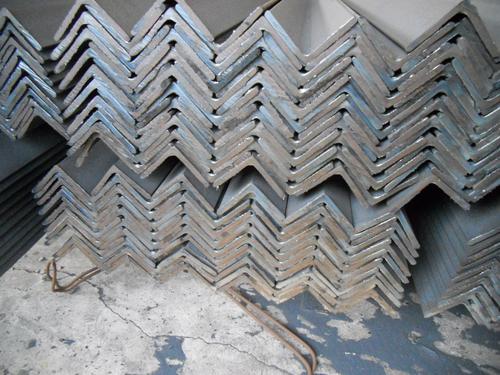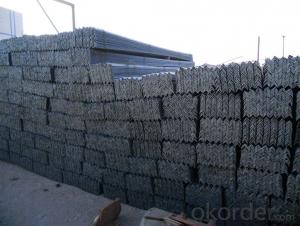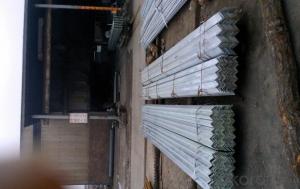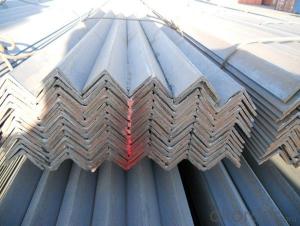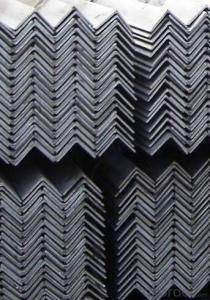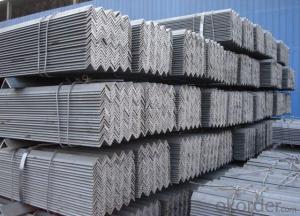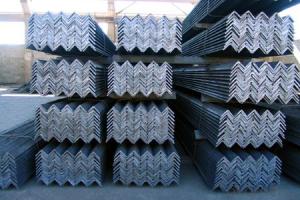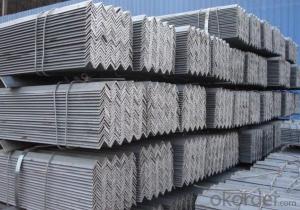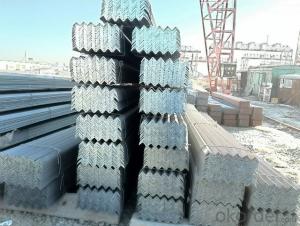High Quality Steel Angle Bar, Angle Steel from China
- Loading Port:
- China main port
- Payment Terms:
- TT or LC
- Min Order Qty:
- 50 m.t.
- Supply Capability:
- 100000 m.t./month
OKorder Service Pledge
OKorder Financial Service
You Might Also Like
Specifications of High Quality Steel Angle Bar, Angle Steel from China
1. Invoicing on theoretical weight or actual weight as customer request
2. Length: 6m, 9m, 12m as following table
3. Sizes

Sizes: 25mm-250mm | ||
a*t | ||
25*2.5-4.0 | 70*6.0-9.0 | 130*9.0-15 |
30*2.5-6.6 | 75*6.0-9.0 | 140*10-14 |
36*3.0-5.0 | 80*5.0-10 | 150*10-20 |
38*2.3-6.0 | 90*7.0-10 | 160*10-16 |
40*3.0-5.0 | 100*6.0-12 | 175*12-15 |
45*4.0-6.0 | 110*8.0-10 | 180*12-18 |
50*4.0-6.0 | 120*6.0-15 | 200*14-25 |
60*4.0-8.0 | 125*8.0-14 | 250*25 |
5. Payment terms:
1).100% irrevocable L/C at sight.
2).30% T/T prepaid and the balance against the copy of B/L.
3).30% T/T prepaid and the balance against L/C
Chemical Components of High Quality Steel Angle Bar, Angle Steel from China
Alloy No | Grade | Element (%) | |||||
C | Mn | S | P | Si | |||
|
|
|
|
|
|
| |
Q235 | B | 0.12—0.20 | 0.3—0.7 | ≤0.045 | ≤0.045 | ≤0.3 | |
|
|
|
|
|
|
| |
Alloy No | Grade | Yielding strength point( Mpa) | |||||
Thickness (mm) | |||||||
≤16 | >16--40 | >40--60 | >60--100 | ||||
≥ | |||||||
|
|
|
|
|
| ||
Q235 | B | 235 | 225 | 215 | 205 | ||
Alloy No | Grade | Tensile strength (Mpa) | Elongation after fracture (%) | ||||
Thickness (mm) | |||||||
| ≤16 | >16--40 | >40--60 | >60--100 | |||
≥ | |||||||
|
|
|
|
|
|
| |
Q235 | B | 375--500 | 26 | 25 | 24 | 23 | |
Usage & Applications of High Quality Steel Angle Bar, Angle Steel from China
According to the needs of different structures, Angle can compose to different force support component, and also can be the connections between components. It is widely used in various building structures and engineering structures such as roof beams, bridges, transmission towers, hoisting machinery and transport machinery, ships, industrial furnaces, reaction tower, container frame and warehouse etc.
Packaging & Delivery of High Quality Steel Angle Bar, Angle Steel from China
1. Packing: it is nude packed in bundles by steel wire rod
2. Bundle weight: not more than 3.5MT for bulk vessel; less than 3 MT for container load
3. Marks:
Color marking: There will be color marking on both end of the bundle for the cargo delivered by bulk vessel. That makes it easily to distinguish at the destination port.
Tag mark: there will be tag mark tied up on the bundles. The information usually including supplier logo and name, product name, made in China, shipping marks and other information request by the customer.
If loading by container the marking is not needed, but we will prepare it as customer request.
Production flow of High Quality Steel Angle Bar, Angle Steel from China
Material prepare (billet) —heat up—rough rolling—precision rolling—cooling—packing—storage and transportation
Pictures of High Quality Steel Angle Bar, Angle Steel from China
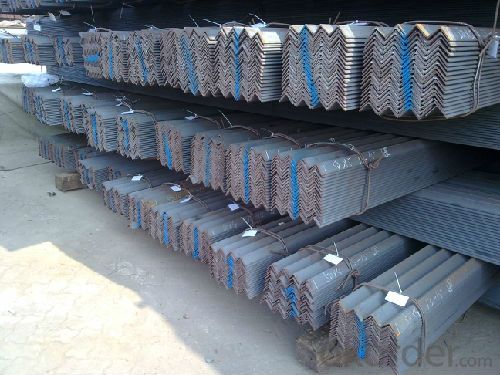

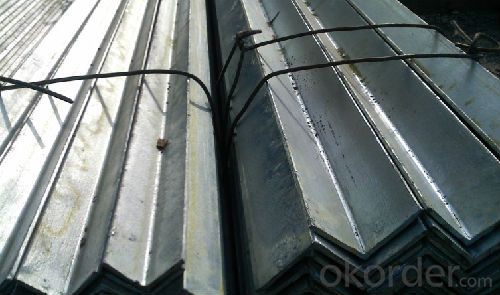
- Q: How do steel angles compare to other structural shapes?
- Steel angles are a versatile and commonly used structural shape in construction and engineering, offering several advantages over beams or channels. To begin with, their L-shaped design provides excellent strength and stability, making them ideal for load-bearing applications. They can effectively resist both compressive and tensile forces, making them suitable for a wide range of structural uses. Furthermore, steel angles have a compact and space-saving profile, making them more efficient in terms of material usage compared to beams or channels. This can result in cost savings and reduced weight in construction projects. Moreover, steel angles can be easily customized to fit specific project requirements. They can be cut, welded, drilled, and modified without compromising their structural integrity, allowing for easy integration into various structural systems. Additionally, steel angles offer versatile connection options. They can be bolted, welded, or riveted, providing flexibility in joining them with other structural components, making them suitable for a wide range of building and construction projects. Lastly, steel angles are readily available and cost-effective. They are widely produced and stocked by steel manufacturers, making them easily accessible. Their affordability, combined with their durability and strength, makes them a popular choice for structural applications. In summary, steel angles excel in strength, space-saving design, adaptability, connection options, and cost-effectiveness compared to other structural shapes. Their versatility and performance make them a preferred choice in various construction and engineering projects.
- Q: Can steel angles be used in signage?
- Signage can indeed utilize steel angles. These versatile and durable structural elements can be effortlessly fabricated and installed in a wide range of applications, including signage. With their exceptional strength and stability, steel angles are ideal for supporting heavy or sizable signs. Moreover, they can be joined through welding, bolting, or riveting, facilitating design flexibility and customization. By painting or coating them, their aesthetic appeal can be enhanced while safeguarding against corrosion, thereby guaranteeing the longevity of the signage. In summary, steel angles provide a dependable and sturdy solution for signage installations.
- Q: What are the different connections used with steel angles?
- There are various connections available for steel angles, depending on the specific application and structural needs. Some commonly used connections for steel angles include the following: 1. Welded connections: Steel angles can be connected through welding, where the edges of the angles are melted and joined using arc welding or MIG welding. Welded connections offer durability and strength, but they require skilled labor and may take time to complete. 2. Bolted connections: Another option is to connect steel angles using bolts. This involves drilling holes through the angles and inserting bolts, securing them in place with nuts and washers. Bolted connections are relatively easy and quick to install, and they allow for easy disassembly if necessary. However, they may not be as strong as welded connections and may require periodic inspection and tightening. 3. Riveted connections: Steel angles can also be connected using rivets. This involves drilling holes through the angles and inserting rivets, which are then hammered or pressed to secure them in place. Riveted connections offer reliability and strength, but they are less commonly used nowadays due to more efficient and cost-effective connection methods. 4. Clip connections: An alternative is to use metal clips or brackets to connect steel angles. These pre-fabricated clips are bolted or welded to the angles, allowing for easy repositioning or removal if needed. Clip connections are often used in situations where adjustability or flexibility is required. 5. Angle connections: In some cases, steel angles can be connected to each other using additional angles. These angles are typically bolted or welded together, providing increased strength and stability. Angle connections are commonly used in structural applications that require additional reinforcement or support. When selecting the appropriate connection method for steel angles, it is crucial to consider project-specific requirements such as load-bearing capacity, structural design, and maintenance. Consulting with a structural engineer or construction professional is recommended to ensure the most suitable connection method is chosen for the specific application.
- Q: Can steel angles be painted or finished for decorative purposes?
- Yes, steel angles can be painted or finished for decorative purposes. Painting or finishing steel angles can enhance their appearance, provide protection against corrosion, and allow for customization to suit specific decorative needs.
- Q: How do you prevent steel angles from bending under load?
- To prevent steel angles from bending under load, there are a few key measures that can be taken: 1. Select the appropriate angle size and material: Ensure that the steel angle chosen is of an adequate size and material strength to withstand the expected load. Consult structural engineering guidelines or professionals to determine the right dimensions and material composition for the specific application. 2. Reinforce the angle: Strengthen the steel angle by adding additional support or reinforcement. This can be achieved through techniques such as welding additional plates to the angle, using gussets or stiffeners, or adding diagonal bracing. These reinforcements help distribute the load more evenly and reduce the risk of bending. 3. Increase the thickness: If possible, increasing the thickness of the steel angle can enhance its load-bearing capacity. A thicker angle will have greater resistance to bending and deformation under load. 4. Proper installation: Ensure that the steel angles are installed correctly and securely to maximize their ability to resist bending. This includes using appropriate fasteners, such as bolts or welds, and following proper installation techniques. 5. Avoid excessive loads: Preventing steel angles from bending under load also involves careful consideration of the maximum load that they will be subjected to. Avoid overloading the angles beyond their design capacity, as this can significantly increase the risk of bending or failure. 6. Regular inspections: Regularly inspect the steel angles for any signs of bending, cracking, or deformation. Timely identification of any potential issues allows for prompt maintenance or reinforcement, preventing further damage or accidents. It is crucial to consult with a qualified structural engineer or professional experienced in steel fabrication to ensure proper design and implementation of these measures to prevent steel angles from bending under load.
- Q: How are steel angles supported during installation?
- Steel angles are typically supported during installation using structural supports such as brackets, beams, or frames. These supports ensure the angles are securely held in place, allowing for proper alignment and stability.
- Q: What is the keel of the aluminum single board suspended or the welded frame of angle steel?
- The marking order of light steel keel is: product name, code name, width of section shape, height, steel plate thickness and standard number. Such as cross section shape is "C" type, width of 50mm, height of 15mm, steel plate thickness of 1.5mm ceiling keel marked: construction light steel keel.
- Q: How do steel angles perform in earthquake-prone regions?
- Steel angles perform well in earthquake-prone regions due to their high strength and flexibility. They are commonly used in structural systems to resist lateral forces and provide stability during seismic events. The angular shape of the steel angles helps in distributing the seismic forces effectively, reducing the risk of structural failure. Additionally, steel's ductility allows it to bend without fracturing, further enhancing its performance in earthquake-prone areas.
- Q: How are steel angles protected against atmospheric corrosion?
- There are various methods available to protect steel angles from atmospheric corrosion. One commonly used method is the application of a protective coating, such as paint, on the surface of the steel angles. This coating acts as a barrier, preventing direct contact between the steel and moisture or oxygen, which are the main causes of corrosion. Another method of protection is galvanization. Galvanization involves coating the steel angles with a layer of zinc, either through hot-dip galvanization or electroplating. The zinc acts as a sacrificial layer, corroding instead of the steel. This sacrificial corrosion process helps safeguard the steel angles from atmospheric corrosion. Apart from coatings, inhibitors can also be used to protect steel angles. Inhibitors are substances that can be added to the environment or applied directly to the steel surface to slow down or prevent corrosion. These inhibitors work by forming a protective film on the steel surface or by altering the chemical environment to reduce corrosion. Regular maintenance and inspection are crucial in protecting steel angles against atmospheric corrosion. This includes cleaning the surface of the steel angles to remove any dirt or debris that can trap moisture and speed up corrosion. It is also important to promptly repair any damaged or deteriorated coatings to ensure continuous protection against corrosion. In conclusion, a combination of protective coatings, galvanization, inhibitors, and regular maintenance is necessary to effectively shield steel angles from atmospheric corrosion and prolong their lifespan.
- Q: Can steel angles be used in the construction of solar panel support structures?
- Yes, steel angles can be used in the construction of solar panel support structures. Steel angles provide structural support and stability, making them suitable for holding solar panels in place and withstanding various weather conditions.
Send your message to us
High Quality Steel Angle Bar, Angle Steel from China
- Loading Port:
- China main port
- Payment Terms:
- TT or LC
- Min Order Qty:
- 50 m.t.
- Supply Capability:
- 100000 m.t./month
OKorder Service Pledge
OKorder Financial Service
Similar products
Hot products
Hot Searches
Related keywords




